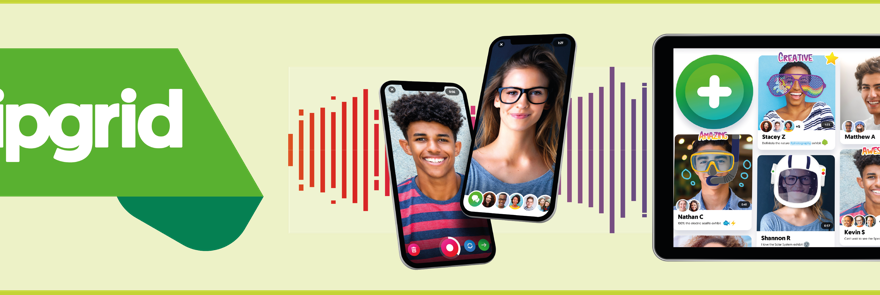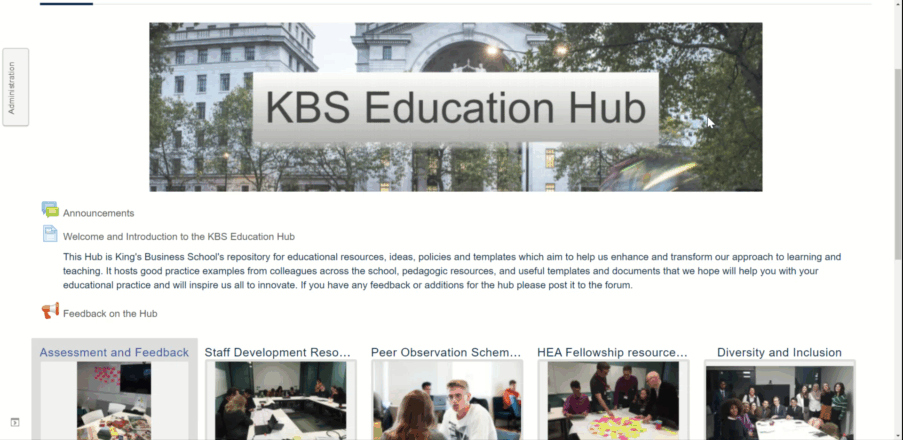Flipgrid, a social learning platform, caught my eye because it looked fun, modern, simple and similar to Snapchat. I have found that students will catch on quickly and are more likely to engage if the ‘tech’ we use for learning can subtly slot into the seamless and even subconscious way they already use technology in their everyday lives. In this post I’ll give you a quick introduction to what Flipgrid is, feedback from a couple of case studies on its uses in Teaching and Learning within King’s Foundations and its potential for further use. Continue reading “Flipgrid: Enhancing Student Voice With a Bit of Fun!”
Category: Pedagogy
King’s Business School Education Hub
In May 2019 the King’s Business School launched a KEATS-based bespoke education hub to act as a one-stop central space to support teaching and learning, list key dates and build a vibrant learning community. It responds to concerns that good practice was not being shared effectively, version control of documents was problematic, and there was no repository to support initiatives such as peer review, GTA induction and education strategy projects. The aim is for it to become a powerful vehicle to enhance pedagogic practice, facilitate communication between staff, increase productivity by offering highly efficient and effective tools for educational delivery and share best practice around digital education.
Moodle Learning Analytics with Power BI
Understanding learner behaviors online is important in addressing challenges they may be facing, offering appropriate support and ensuring the instructional design meets their needs. This is the object of Learning Analytics (LA), which aims to analyse and optimize learning and the environments in which it occurs. Continue reading “Moodle Learning Analytics with Power BI”
Part 2: Video Lectures for a Partially Flipped Classroom
This article has been divided into two parts. Part 1 is about the Production process and Part 2 discusses Student engagement, feedback, and reflections.
In the summer of 2018, I challenged myself to produce video “preludes” to create a partially flipped classroom for an Organic Chemistry module. This second blog entry covers how the videos were used in the course, student viewing figures and feedback, and where the project might lead in the future. Continue reading “Part 2: Video Lectures for a Partially Flipped Classroom”
Part 1: Video Lectures for a Partially Flipped Classroom
This article has been divided into two parts. Part 1 is about the Production process and Part 2 discusses Student engagement, feedback, and reflections.
In the summer of 2018, I challenged myself to produce video “prelude” lectures to create a partially flipped classroom for an Organic Chemistry module. This first blog entry describes the creation process. Continue reading “Part 1: Video Lectures for a Partially Flipped Classroom”
Keep your students engaged and active with audience response tools
Using active learning techniques can benefit student learning outcomes and can also encourage student engagement. The audience response tool Poll Everywhere is a good way to encourage active learning through the use of a mobile phone or laptop. Continue reading “Keep your students engaged and active with audience response tools”
Part 2: Navigating the VLE for an assessment treasure hunt
This article has been divided into two parts. Part 1 includes Problem & Chosen Solution and Part 2 discusses a short assessment of the outcome.
This academic year we tried something new to get students to engage with assessment material. We set them a treasure hunt to find key information about their assessment. All those who followed the instructions and obtained the correct information were entered into a prize draw for a £15 Amazon voucher. This blog describes how we designed the task, what happened and what we learnt about our own assessment.
Continue reading “Part 2: Navigating the VLE for an assessment treasure hunt”
Part 1: Navigating the VLE for an assessment treasure hunt
This article has been divided into two parts. Part 1 includes Problem & Chosen Solution and Part 2 discusses a short assessment of the outcome.
This academic year we tried something new to get students to engage with assessment material. We set them a treasure hunt to find key information about their assessment. All those who followed the instructions and obtained the correct information were entered into a prize draw for a £15 Amazon voucher. This blog describes how we designed the task, what happened and what we learnt about our own assessment.
Continue reading “Part 1: Navigating the VLE for an assessment treasure hunt”



